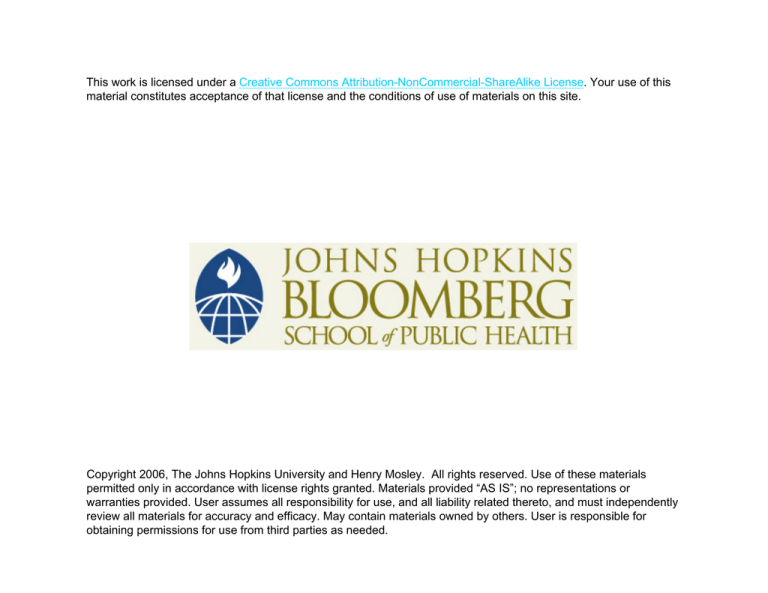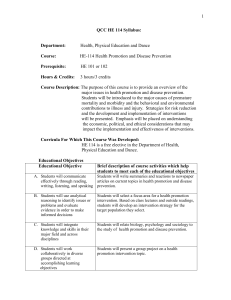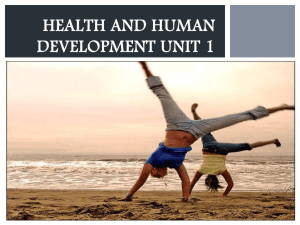
This work is licensed under a Creative Commons Attribution-NonCommercial-ShareAlike License. Your use of this
material constitutes acceptance of that license and the conditions of use of materials on this site.
Copyright 2006, The Johns Hopkins University and Henry Mosley. All rights reserved. Use of these materials
permitted only in accordance with license rights granted. Materials provided “AS IS”; no representations or
warranties provided. User assumes all responsibility for use, and all liability related thereto, and must independently
review all materials for accuracy and efficacy. May contain materials owned by others. User is responsible for
obtaining permissions for use from third parties as needed.
Mortality and Morbidity Trends
and Differentials
Determinants and Implications for the
Future
Module 7a
Learning Objectives
Upon completion of this module, the
student will be able to:
– Describe the recent trends and
differentials in mortality
– List and describe the proximate and
underlying determinants of morbidity
and mortality
Health Transition
Demographic
Transition
Urbanization
Industrialization
Expansion of
education
Improved medical
and public health
technology
Infectious
disease
mortality
declines
Epidemiologic
Transition
Fertility
declines
Population
ages
Economic
recession
and
increasing
inequality
Chronic and
noncommunicable
diseases
emerge
Persistence or
re-emergence
of communicable diseases
Protracted-polarized
Epidemiologic Transition
Relations Among the Demographic, Epidemiologic and Health Transitions
Life Expectancy Gains in Major
World Regions, 1950-55 to 1995-00
1950-55
90
76.9
Life expectancy
80
70
69
73.3
66.2
60
69.2
66.3
51.4
50
1995-00
51.4
41.3
40
37.8
30
20
10
0
N. America
Europe
L. America
Asia
Africa
The Structure of Mortality
High Mortality
Young Age
Structure
Infectious
Diseases
Low Mortality
Older Age
Structure
Chronic
Diseases
Matlab, Bangladesh
Percent distribution of population and deaths, 1987
85+
80
75
70
65
60
55
50
45
40
35
30
25
20
15
10
5
0
Population
Deaths
Median age at death
16 14 12 10
Data Source: ICDDR,B
8
6
4
2
0
10
20
30
40
50
Sweden
Percent distribution of population and deaths, 1985
85+
80
75
70
65
60
55
50
45
40
35
30
25
20
15
10
5
0
Median
age at
death
Population
10
8
6
Deaths
4
2
Data Source: Keyfitz and Flieger, 1990
0
5
10
15
20
25
Proportions of Deaths Due to Communicable
and Non-communicable Diseases and to Injuries;
Europe and Africa, 1998
Africa
Europe
8%
8%
12%
22%
66%
84%
Communicable diseases
Noncommunicable diseases
(Source: WHO, World Health Report, 1999)
Injuries
Age and Cause Distribution of
Deaths in Chile for Females
1909 and 1999
Source: Fig 1.1, World Health Report,1999
Determinants of Variations in
Morbidity and Mortality
Proximate determinants: Factors that that
directly influence the risk of disease and
the outcomes of disease processes in
individuals.
Distal (underlying) determinants: Social,
economic, and cultural factors that
influence the health status of a population
by operating through one or more of the
proximate causes.
Proximate Determinants Of
Morbidity and Mortality
Personal behaviors: Diet, hygiene, alcohol and
tobacco use, sexual behavior, etc.
Environmental exposures: Exposure to infectious
or chemical or physical agents, occupational
hazards, etc.
Nutrition: Under nutrition, micronutrient
deficiency, over nutrition/obesity etc.
Injuries: Intentional or accidental injuries.
Personal illness control: Specific preventive and
sickness care actions.
Underlying Determinants Of
Morbidity and Mortality
Socio-economic factors: Household wealth, community
development, women’s education and employment,
etc.
Institutional factors: Health systems, health
regulations, technological developments, information
programs, environmental interventions, etc.
Cultural factors: Traditional beliefs about health and
disease, religious values, role and status of women etc.
Broader context: Ecological setting, political economy,
transportation and communication systems,
agricultural development, markets, urbanization, etc.
A Determinants of Morbidity and
Mortality Framework
Socio-economic, cultural and
institutional factors
Health
behaviors
Environmental
exposure
Healthy
Nutrition
Sick
Injury
Death
Prevention
Personal illness
control
Treatment
(Adapted from Mosley and
Chen, 1983)
Summary Slide
This concludes this lecture. The key concepts
introduced in the lecture include:
– Health transition
– Regional trends in life-expectancy gains
– Proximate and distal determinants of
variations in morbidity and mortality
Mortality and Morbidity Trends
and Differentials
Determinants and Implications for the
Future
Module 7b
Learning Objectives
Upon completion of this module, the
student will be able to:
– Analyze the relationship between
indicators of development and health
Income and Health – What Are
the Relationships?
Historically – a dual relationship
1. In a specific time period (e.g., 1900, 1930,
1960) higher incomes were associated with
higher life expectancies.
2. Over several decades, however, the same
level of income was associated with a higher
level of life expectancy.
3. This gain in life expectancy over time
without a corresponding change in income has
been termed a “structural shift” by
economists.
“Structural
shift” in the
relationship
between
life
expectancy
and income,
1930-1990
Source: World
Bank, World
Development
Report 1993
Structural Shift : Income And Infant
Mortality Rates, 1952 - 1992
Source: Fig 1.4, World Health Report,1999
Income And Mortality: Explaining
The Historical Relationships
Moving along the income/survival curve:
Achieved by reducing health risks and being
able to utilize the existing services more
effectively with higher incomes.
Shifting to a higher income/survival curve:
Achieved by access to low cost and better
health technologies (vaccinations, antibiotics,
safe water and sanitation, vector control
campaigns, information, etc.).
– This was responsible for almost half of
the gains in health between 1952 and
1992 in LDCs (WHO).
Selected Developing Countries with High or Low
Average Life Expectancies Relative to GNP Per Capita
Percent literate
Total
Life
GNP/capita
US dollars Expectancy fertility rate Females
Males
Country
(1990)
Years (1990)
(1988)
(1985)
A. Life expectancy over 70 years with GNP/capita under $2,000
Sri Lanka
420
71
2.5
81
92
Chile
1,510
72
2.7
92
93
Malaysia
1,940
70
3.7
65
83
B. Life expectancy under 65 years with GNP/capita over $2,000
Saudi Arabia
6,200
64
7.1
43
69
Gabon
2,970
53
5.5
43
70
Algeria
2,360
64
5.4
35
63
(Source: Mosley and Cowley, 1991)
Female Education And Mortality
The Demographic and Health Surveys
have documented a consistent
relationship between higher maternal
education and lower levels of mortality
among children under 5 years of age.
This has been observed in countries in
Africa, Asia and Latin America.
Under-five mortality rates by mother’s education
in the period 0-9 years preceding the survey,19901999, DHS, SSA
350
300
250
200
None
Primary
150
100
50
0
Secondary or higher
Female Education And Mortality
Almost one-third of global health gains
as measured by mortality reduction in
the period 1960-1990 are attributed to
gains in female education.
This is been shown to operate in part
through more educated mothers being
able to reduce health risks and being
better able to access modern health
services.
Summary Slide
This concludes this session. The key
concepts introduced in the lecture include
– Relationship between income and health
– Relationship between woman’s
education and health
Mortality and Morbidity Trends
and Differentials
Determinants and Implications for the
Future
Module 7c
Learning Objectives
Upon completion of this module, the
student will be able to:
– Explain what is meant by the Health and
Epidemiologic Transitions and
Epidemiologic Polarization and what are
the implications for the future
The Epidemiological Transition:
Elements
Shift in age structure of the mortality;
from younger age groups to older age
groups
Change in patterns of mortality and
morbidity by cause of death; from
infectious diseases to non-communicable
diseases
The Epidemiological Transition:
Historical Stages
The age of pestilence and famine
– Precedes the mortality transition; LE =
<40yrs
The age of receding pandemics
– Less variation in mortality with steady
decline
The age of degenerative or human-made
diseases
– Life expectancy reaches 70 years and above
(Source: Omran, 1971)
The Epidemiological Transition:
The Future?
The age of delayed degenerative diseases?
–
With health advancements, chronic diseases
are postponed to much later in life
The age of emerging/re-emerging infectious and
parasitic diseases?
–
New infectious diseases (such as HIV/AIDS)
may continue to appear and old diseases
return because of antibiotic resistance and
compromised immune systems among the
elderly
Epidemiological Polarization
Widening of the gap in the health status
among social classes or geographical
regions due to unequal distribution of gains
of development and incomplete/ unequal
coverage of health interventions.
continued
Epidemiological Polarization
Can refer to widening of the health status gap
between countries or between social groups
within a country
Characterized by overlap of eras; persistence
of infectious diseases with emergence of noncommunicable diseases
Observed in the developed and developing
countries alike.
continued
Epidemiological Polarization
Mortality “reversals” due to economic
collapse, wars and emerging epidemic
diseases can be factors causing widening
gaps across countries. Examples are:
– Economic collapse – Russia (Former
Soviet Union)
– Wars – Former Yugoslavia, Rwanda
– Emerging epidemics – HIV/AIDS in SubSaharan Africa
Projected Effect of AIDS on Life Expectancy
in Sub-Saharan Africa by the Year 2010
With AIDS
Without AIDS
69.9
Zimbabwe
33.1
67.9
South Africa
47.8
54.5
Uganda
35.2
64.9
59.7
Nigeria
69.2
Kenya
43.2
59.8
Congo
51.3
0
20
40
60
80
Life Expectancy
Source: U.S. Bureau of Census International Programs, 1997
Population Aging and “Compression”
of Mortality and Morbidity
Compression of mortality : Increasing
concentration of deaths at upper ages
– Is there an upper limit to life expectancy?
Compression of morbidity: An increasing
concentration of illness and disability in the
latter years of life with fewer years of
disabled life before death among the elderly
– Are health gains matching or exceeding
gains in survival?
Compression of Morbidity with Gain
in Life Expectancy
Compression of
morbidity
Years lived
No compression of
morbidity
Healthy
Morbidity
Disabled
Population Aging and “Compression”
of Mortality and Morbidity
If there is no “compression” of mortality, and
no postponement of morbidity, then life
expectancy may steadily increase but years
lived with morbidity and disability would also
increase.
This can result in growing numbers of
chronically ill and disabled elderly, creating
an increasing burden on health systems.
Summary Slide
This concludes this lecture. The key
concepts introduced in this lecture
include:
– Epidemiological transition
– Epidemiological polarization
– Compression of mortality and
morbidity






